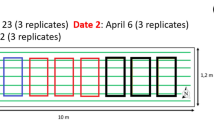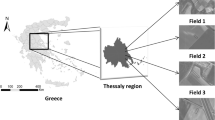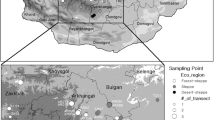Abstract
This study combines proximal sensing technology based on a mobile visible imaging device and a dynamic ecophysiological model to estimate the growth status of two winter wheat crops (Apache and Rubisko cultivars) in the presence of uncontrolled broadleaf weeds. Working at early growth stages and on four different dates, each plot was photographed and then destructive biomass samples were collected. After calibration, crop aboveground biomass is inferred from an image indicator, the fractional vegetation cover (FVC). A supervised image classification algorithm was used to calculate FVC for crop (FVCc) and for weeds (FVCw). Analysis of FVC measurements focused on stand heterogeneity by comparing their variability and the impact of weeds on crop growth. Over time, the discrepancy between plant biomass derived from the image and data simulated from a simple ecophysiological model increased for most areas of the plot, indicating the presence of crop stress. At the same time, the weed pressure (WP) study concluded that weeds did not have a major influence on crop growth, although locally some areas showed a negative impact on crop growth. Therefore, weeds were not the major stress observed on the later dates of the study. These low-cost technologies aim to determine stress in wheat crop and support farmers in their transition to agroecology for highly accurate plot monitoring.








Similar content being viewed by others
References
Aase, J. K. (1978). Relationship between leaf area and dry matter in winter wheat. Agronomy Journal, 70, 563–565.
Bah, M. D., Hafane, A., & Canals, R. (2018). Deep Learning with unsupervised data labelling for weeds detection on UAV images. Remote Sensing, 10(11), 1690. https://doi.org/10.3390/rs10111690
Barnard, H. R., Findley, M. C., & Csavina, J. (2014). A simple and inexpensive device for logging photosynthetically active radiation. Tree Physiology, 34, 640–645. https://doi.org/10.1093/treephys/tpu044
Beillouin, D., Leclère, M., Barbu, C. M., Bénézit, M., Trépos, R., Gauffreteau, A., & Jeuffroy, M.-H. (2018). Azodyn-Barley, a winter-barley crop model for predicting and ranking genotypic yield, grain protein and grain size in contrasting pedoclimatic conditions. Agricultural and Forest Meteorology, 262, 237–248. https://doi.org/10.1016/j.agrformet.2018.06.002
Berge, T. W., Goldberg, S., Kaspersen, K., & Netland, J. (2012). Towards machine vision based site-specific weed management in cereals. Computers and Electronics in Agriculture, 81, 79–86. https://doi.org/10.1016/j.compag.2011.11.004
Boschert, S., & Rosen, R. (2016). Digital twin—The simulation aspect. In P. Hehenberger & D. Bradley (Eds.), Mechatronic futures: Challenges and solutions for mechatronic systems and their designers (pp. 59–74). Springer.
Brisson, N., Gary, C., Justes, E., Roche, R., Mary, B., Ripoche, D., et al. (2003). An overview of the crop model STICS. European Journal of Agronomy, 18, 309–332. https://doi.org/10.1016/S1161-0301(02)00110-7
Calvert, B., Olsen, A., Whinney, J., & Azghadi, M. R. (2021). Robotic spot spraying of Harrisia Cactus (Harrisia martinii) in grazing pastures of the Australian Rangelands. Plants, 10(10), 2054. https://doi.org/10.3390/plants10102054
Casadesús, J., & Villegas, D. (2014). Conventional digital cameras as a tool for assessing leaf area index and biomass for cereal breeding. Journal of Integrative Plant Biology, 56(1), 7–14. https://doi.org/10.1111/jipb.12117
Caussanel, P. J. (1989). Nuisibilité et seuils de nuisibilité des mauvaises herbes dans une culture annuelle: Situation de concurrence bispécifique (Injurious effects of weeds and weed thresholds in an annual arable crop: Interference between two species). Agronomie, 9, 219–240. https://doi.org/10.1051/agro:19890301
Christensen, C., Søgaard, H. T., Kudsk, P., Nørremark, M., Lund, I., Nadimi, E. S., & Jørgensen, R. (2009). Site-specific weed control technologies. Weed Research, 49, 233–241. https://doi.org/10.1111/j.1365-3180.2009.00696.x
Coffin, A., Bonnefoy-Claudet, C., Chassaigne, M., Jansen, A., & Gée, C. (2021). PARADe: A low-cost open-source device for photosynthetically active radiation (PAR) measurements. Smart Agricultural Technology. https://doi.org/10.1016/j.atech.2021.100018
Colbach, N., & Cordeau, S. (2018). Reduced herbicide use does not increase crop yield loss if it is compensated by alternative preventive and curative measures. European Journal of Agronomy, 94, 67–78. https://doi.org/10.1016/j.eja.2017.12.008
Corre-Hellou, G., Faure, M., Launay, M., Brisson, N., & Crozat, Y. (2009). Adaptation of the STICS intercrop model to simulate crop growth and N accumulation in pea–barley intercrops. Field Crops Research, 113, 72–81. https://doi.org/10.1016/j.fcr.2009.04.007
Duru, M., Therond, O., & Fares, M. (2015). Designing agroecological transitions. A review. Agronomy for Sustainable Development, 35(4), 1237–1257. https://doi.org/10.1007/s13593-015-0318-x
Foley, J. A. (2011). Can we feed the world and sustain the planet? Scientific American, 305, 60–65.
Foley, J. A., Ramankutty, N., Brauman, K. A., Cassidy, E. S., Gerber, J. S., et al. (2011). Solutions for a cultivated planet. Nature, 478, 337–342. https://doi.org/10.1038/nature10452
Gée, C., & Denimal, E. (2020). Two new non-destructive image-derived indicators for spatial assessment of the impact of broadleaf weeds on wheat biomass. Remote Sensing, 12(18), 2982. https://doi.org/10.3390/rs12182982
Gée, C., Denimal, E., Merienne, J., & Larmure, A. (2021). Evaluation of weed impact on wheat biomass by combining visible imagery with a plant growth model: Towards new non-destructive indicators for weed competition. Precision Agriculture Journal, 22(2), 550–568. https://doi.org/10.1007/s11119-020-09776-6
Gée, C., Mignon, V., Dujourdy, L., & Denimal, E. (2021a). Chapter 26. High throughput field phenotyping (HTFP) of wheat and weed cover in field experiments using RGB images: assessment of crop-weed competition with a simple ecophysiological model. In Proceedings of 12th European conference on precision agriculture (pp. 225–232). Wageningen Academic Publishers.
Grieves, M., & Vickers, J. (2017). Digital twin: Mitigating unpredictable, undesirable emergent behaviour in complex systems. In F.-J. Kahlen, S. Flumerfelt, & A. Alves (Eds.), Transdisciplinary perspectives on complex systems. Springer.
Jeuffroy, M. H., & Recous, S. (1999). Azodyn: A simple model simulating the date of nitrogen deficiency for decision support in wheat fertilization. European Journal of Agronomy, 10, 129–144. https://doi.org/10.1016/S1161-0301(98)00059-8
Jeuffroy, M. H., Valantin-Morison, M., Champolivier, L., & Reau, R. (2006). Azote, rendement et qualité des graines: Mise au point et utilisation du modèle Azodyn-colza pour améliorer les performances du colza vis-à-vis de l’azote (Nitrogen, yield and seed quality: Design and uses of the Azodyn-rape model to improve rape performances for nitrogen). Oilseeds and Fats, Crops and Lipids, 13(6), 388–392. https://doi.org/10.1051/ocl.2006.0090
Keating, B. A., Carberry, P. S., Hammer, G. L., Probert, M. E., Robertson, M. J., Holzworth, D., et al. (2003). An overview of APSIM, a model designed for farming systems simulation. European Journal of Agronomy, 18, 267–288. https://doi.org/10.1016/S1161-0301(02)00108-9
Kruepl, C., Hoad, S., Davies, K., Bertholdsson, N.-O, & Paolini, R. (2006). Weed competitiveness. Handbook cereal variety testing for organic and low input agriculture.
Liu, H. Q., & Huete, A. R. (1995). A feedback based modification of the NDVI to minimize canopy background and atmospheric noise. IEEE Transactions on Geoscience and Remote Sensing, 33, 457–465. https://doi.org/10.1109/36.377946
Louargant, M., Jones, G., Faroux, R., Paoli, J. N., Maillot, T., Gée, C., & Villette, S. (2018). Unsupervised classification algorithm for early weed detection in row-crops by combining spatial and spectral information. Remote Sensing, 10(5), 761. https://doi.org/10.3390/rs10050761
Lu, N., Zhou, J., Han, Z., Li, D., Cao, Q., Yao, X., Tian, Y., Zhu, Y., Cao, W., & Cheng, T. (2019). Improved estimation of aboveground biomass in wheat from RGB imagery and point cloud data acquired with a low-cost unmanned aerial vehicle system. Plant Methods, 15(1), 17. https://doi.org/10.1186/s13007-019-0402
Mamine, F., & Farès, M. (2020). Barriers and levers to developing wheat–pea intercropping in Europe: A review. Sustainability, 12(17), 696. https://doi.org/10.3390/su12176962
Martinez-Guanter, J., Egea, G., Perez-Ruiz, M., & Apolo-Apolo, O. E. (2019). Estimation of the leaf area index in maize based on UAV imagery using deep learning techniques. In J. V. Stafford (Ed.), Proceedings of 12th European conference on precision agriculture (pp. 389–393). Wageningen Academic Publishers.
Mézière, D., Petit, S., Granger, S., Biju-Duval, L., & Colbach, N. (2015). Developing a set of simulation based indicators to assess harmfulness and contribution to biodiversity of weed communities in cropping systems. Ecological Indicators, 48, 157–170. https://doi.org/10.1016/j.ecolind.2014.07.028
Monteith, J. L. (1972). Solar radiation and productivity in tropical ecosystems. Journal of Applied Ecology, 9, 747–766. https://doi.org/10.2307/2401901
Monteith, J. L. (1977). Climate and the efficiency of crop production in Britain. Philosophical Transactions of the Royal Society of London Series B Biological Sciences, 281, 277–294. https://doi.org/10.1098/rstb.1977.0140
Oerke, E. C., & Dehne, H. W. (2004). Safeguarding production—Losses in major crops and the role of crop protection. Crop Protection, 23, 275–285. https://doi.org/10.1016/j.cropro.2003.10.001
Paruelo, J. M., Lauenroth, W. K., & Roset, P. A. (2000). Technical note: Estimating aboveground plant biomass using a photographic technique. Journal of Range Management, 53, 190–193. https://doi.org/10.2307/4003281
R Core Team. (2020). R: A language and environment for statistical computing. R foundation for Statistical Computing. Retrieved Oct 2022 from https://www.Rproject.org
Roujean, J. L., & Breon, F. M. (1995). Estimating PAR absorbed by vegetation from bidirectional reflectance measurements. Remote Sensing of Environment, 51, 375–384. https://doi.org/10.1016/0034-4257(94)00114-3
Rouse, J. W., Hass, R. H., Shell, J. A., & Deering, D. W. (1973). Monitoring vegetation systems in the great plains with ERTS. In Proceedings 3rd earth resources technology satellite symposium; Washington, DC, 10–14 December (pp. 309–317). NASA
RStudio Team. (2020). RStudio: Integrated development environment for R. RStudio Inc.
Sa, I., Popović, M., Khanna, R., Chen, Z., Lottes, P., Liebisch, F., et al. (2018). WeedMap: A large-scale semantic weed mapping framework using aerial multispectral imaging and deep neural network for precision farming. Remote Sensing, 10(9), 1423. https://doi.org/10.3390/rs10091423
Sokal, R. R., & Rohlf, F. J. (1995). Biometry: The principles and practice of statistics in biological research (3rd ed.). W.H. Freeman and Co.
Suh, H. K., Hofstee, J. W., Ijsselmuiden, J., & van Henten, E. J. (2018). Sugar beet and volunteer potato classification using Bag-of-Visual-Words model. Scale-invariant feature transform or speeded up robust feature descriptors and crop row information. Biosystems Engineering, 166, 210–226. https://doi.org/10.1016/j.biosystemseng.2017.11.015
Thébault, A., Pierron, S., & Achard, A. (2019). Discrimination automatique des espèces par imagerie en intelligence artificielle. Application au cas de l'ambroisie à feuilles d'armoise. Automatic discrimination of species by images and artificial intelligence. Application to common ragweed. In Proceedings of 24e conférence du COLUMA—Journées internationales sur la lutte contre les mauvaises herbes. AFPP Press.
Van Evert, F. K., Fountas, S., Jakovetic, D., Crnojevic, V., Travlos, I., & Kempenaar, C. (2017). Big data for weed control and crop protection. Weed Research, 57(4), 218–233. https://doi.org/10.1111/wre.12255
Verdouw, C., Tekinerdogan, B. R., Beulens, A., & Wolfert, S. (2021). Digital twins in smart farming. Agricultural Systems, 189, 103046. https://doi.org/10.1016/j.agsy.2020.103046
Vescovo, L., Wohlfahrt, G., Balzaro, M., Pilloni, S., Sottocornola, M., Rodeghiero, M., & Gianelle, D. (2012). New spectral vegetation indices based on the near-infrared shoulder wavelengths for remote detection of grassland phytomass. International Journal of Remote Sensing, 33(7), 2178–2195. https://doi.org/10.1080/01431161.2011.607195
Weiss, M., Jacob, F., & Duveiller, G. (2020). Remote sensing for agricultural applications: A meta-review. Remote Sensing of Environment, 236, 111402. https://doi.org/10.1016/j.rse.2019.111402
Wenzhu, Y., Sile, W., Xiaolan, Z., Jingsi, Z., & Jiaqi, F. (2015). Greenness identification based on HSV decision tree. Information Processing in Agriculture, 2(3–4), 149–160. https://doi.org/10.1016/j.inpa.2015.07.003
Wezel, A., Casagrande, M., Celette, F., Vian, J. F., Ferrer, A., & Peigné, J. (2014). Agroecological practices for sustainable agriculture. A review. Agronomy for Sustainable Development, 34, 1–20. https://doi.org/10.1007/s13593-013-0180-7
Acknowledgements
The authors would like to thank Vincent Durey and Annick Matéjicek who were involved in this project, one on PAR sensor control and the other for plant identification. Thanks to Arnaud Coffin for his mastery of the R software and the realization of some figures of the article.
Author information
Authors and Affiliations
Corresponding author
Ethics declarations
Conflict of interest
The authors declare no conflict of interest.
Additional information
Publisher's Note
Springer Nature remains neutral with regard to jurisdictional claims in published maps and institutional affiliations.
Appendices
Appendix 1
Appendix 2
See Table 3.
Appendix 3
Rights and permissions
Springer Nature or its licensor holds exclusive rights to this article under a publishing agreement with the author(s) or other rightsholder(s); author self-archiving of the accepted manuscript version of this article is solely governed by the terms of such publishing agreement and applicable law.
About this article
Cite this article
Gée, C., Dujourdy, L., Mignon, V. et al. Proxi-detection to monitor the growth status of wheat in the presence of weeds using low-cost and simple digital tools to track the emergence of stress. Precision Agric 23, 2115–2134 (2022). https://doi.org/10.1007/s11119-022-09963-7
Accepted:
Published:
Issue Date:
DOI: https://doi.org/10.1007/s11119-022-09963-7






